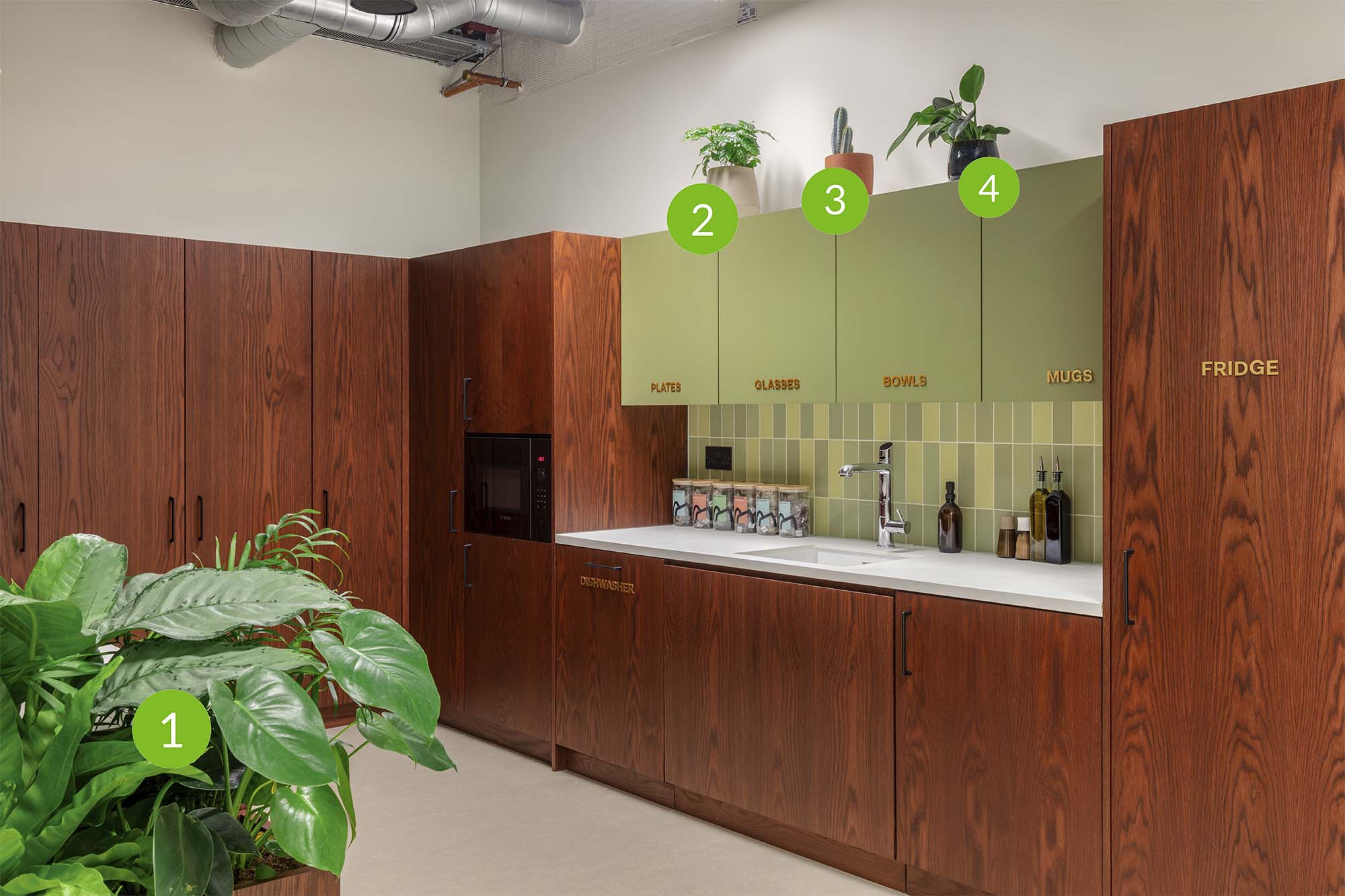MYO, Bankside

In This Image
1. Monstera Deliciosa
Common name: Swiss Cheese Plant
Latin name: Monstera deliciosa
Origin: Native to the rainforests of Central America, particularly Mexico and Guatemala
Air cleaning score: 8/10
Other varieties: Monstera adansonii (Swiss Cheese Vine) is a related species with smaller, more perforated leaves that trail and climb
2. Fatsia Japonica
Common name: Japanese Aralia
Latin name: Fatsia japonica
Origin: Native to Japan, South Korea, and Taiwan
Air cleaning score: 7/10
Other varieties: Fatsia japonica ‘Spider’s Web’ is a popular cultivar with white-speckled leaves, offering a variegated look. Another notable variety is Fatsia japonica ‘Annelise,’ which has striking yellow and green foliage.

In This Image
1. Mixed Planting
Common names:
Philodendron ‘Green Princess’ – Green Princess
Philodendron Asplenium antiquum – Japanese Bird’s Nest Fern
Chamaedorea elegans – Parlor Palm
Aglaonema ‘Cintho King’ – Cintho King Chinese Evergreen
Monstera deliciosa – Swiss Cheese Plant
Latin names:
Philodendron ‘Green Princess’
Asplenium antiquum
Chamaedorea elegans
Aglaonema ‘Cintho King’
Monstera deliciosa
Origins:
Philodendron ‘Green Princess’ – Central and South America
Asplenium antiquum – East Asia (Japan, Taiwan)
Chamaedorea elegans – Southern Mexico and Guatemala
Aglaonema ‘Cintho King’ – Tropical Asia Monstera deliciosa – Central America, especially Mexico and Guatemala
Air cleaning scores:
Philodendron ‘Green Princess’ – 8/10
Asplenium antiquum – 7/10
Chamaedorea elegans – 8/10
Aglaonema ‘Cintho King’ – 8/10
Monstera deliciosa – 8/10

In This Image
1. Ficus Lyrata
Common name: Fiddle-Leaf Fig
Latin name: Ficus lyrata
Origin: Africa
Air cleaning score: 5/10
Other varieties: Ficus elastica (Rubber Plant)
2. Strelitzia Nicolai
Common name: Giant White Bird of Paradise
Latin name: Strelitzia nicolai
Origin: Native to South Africa
Air cleaning score: 7/10
Other varieties: Related varieties include Strelitzia reginae, known as the Bird of Paradise, which has striking orange and blue flowers, and Strelitzia alba, a rare species with large, white flowers.

In This Image
1. Mixed Planting
Common names:
Philodendron ‘Green Princess’ – Green Princess
Philodendron Asplenium antiquum – Japanese Bird’s Nest Fern
Chamaedorea elegans – Parlor Palm
Aglaonema ‘Cintho King’ – Cintho King Chinese Evergreen
Monstera deliciosa – Swiss Cheese Plant
Latin names:
Philodendron ‘Green Princess’
Asplenium antiquum
Chamaedorea elegans
Aglaonema ‘Cintho King’
Monstera deliciosa
Origins:
Philodendron ‘Green Princess’ – Central and South America
Asplenium antiquum – East Asia (Japan, Taiwan)
Chamaedorea elegans – Southern Mexico and Guatemala
Aglaonema ‘Cintho King’ – Tropical Asia Monstera deliciosa – Central America, especially Mexico and Guatemala
Air cleaning scores:
Philodendron ‘Green Princess’ – 8/10
Asplenium antiquum – 7/10
Chamaedorea elegans – 8/10
Aglaonema ‘Cintho King’ – 8/10
Monstera deliciosa – 8/10

In This Image
1. Strelitzia Nicolai
Common name: Giant White Bird of Paradise
Latin name: Strelitzia nicolai
Origin: Native to South Africa
Air cleaning score: 7/10
Other varieties: Related varieties include Strelitzia reginae, known as the Bird of Paradise, which has striking orange and blue flowers, and Strelitzia alba, a rare species with large, white flowers.
2. Howea Forsteriana
Common name: Kentia Palm, Thatch Palm
Latin name: Howea forsteriana
Origin: Native to Lord Howe Island, Australia
Air cleaning score: 7/10
Other varieties: Related palms include the Howea belmoreana (Belmore Sentry Palm), which has a more compact, arching growth form.
3. Ficus Lyrata
Common name: Fiddle-Leaf Fig
Latin name: Ficus lyrata
Origin: Africa
Air cleaning score: 5/10
Other varieties: Ficus elastica (Rubber Plant)
4. Philodendron Scandens
Common name: Heartleaf Philodendron, Sweetheart Plant
Latin name: Philodendron scandens
Origin: Native to the tropical regions of Central and South America
Air cleaning score: 8/10
Other varieties: Related varieties include Philodendron hederaceum (also known as Philodendron scandens), and Philodendron ‘Brazil’, which has green and yellow variegation.

In This Image
1. Mixed Planting
Common names:
Philodendron ‘Green Princess’ – Green Princess
Philodendron Asplenium antiquum – Japanese Bird’s Nest Fern
Chamaedorea elegans – Parlor Palm
Aglaonema ‘Cintho King’ – Cintho King Chinese Evergreen
Monstera deliciosa – Swiss Cheese Plant
Latin names:
Philodendron ‘Green Princess’
Asplenium antiquum
Chamaedorea elegans
Aglaonema ‘Cintho King’
Monstera deliciosa
Origins:
Philodendron ‘Green Princess’ – Central and South America
Asplenium antiquum – East Asia (Japan, Taiwan)
Chamaedorea elegans – Southern Mexico and Guatemala
Aglaonema ‘Cintho King’ – Tropical Asia Monstera deliciosa – Central America, especially Mexico and Guatemala
Air cleaning scores:
Philodendron ‘Green Princess’ – 8/10
Asplenium antiquum – 7/10
Chamaedorea elegans – 8/10
Aglaonema ‘Cintho King’ – 8/10
Monstera deliciosa – 8/10
2. Monstera minima
Common name: Mini Monstera, Rhaphidophora Tetrasperma
Latin name: Monstera minima (also known as Rhaphidophora tetrasperma)
Origin: Native to Southeast Asia, particularly Thailand and Malaysia
Air cleaning score: 8/10
Other varieties: Related varieties include Monstera deliciosa (Swiss Cheese Plant) and Monstera adansonii, both with larger, more dramatic leaves.
3. Pilosocereus Azureus
Common name: Blue Torch Cactus
Latin name: Pilosocereus azureus
Origin: Native to the deserts of Mexico
Air cleaning score: 5/10
Other varieties: Related varieties include Pilosocereus leucocephalus and Pilosocereus pachycladus, both known for their unique blue-gray hues.
4. Philodendron Scandens
Common name: Heartleaf Philodendron, Sweetheart Plant
Latin name: Philodendron scandens
Origin: Native to the tropical regions of Central and South America
Air cleaning score: 8/10
Other varieties: Related varieties include Philodendron hederaceum (also known as Philodendron scandens), and Philodendron ‘Brazil’, which has green and yellow variegation.

In This Image
1. Pseudosasa japonica
Common name: Japanese Arrow Bamboo
Latin name: Pseudosasa japonica
Origin: Native to Japan
Air cleaning score: 7/10
Other varieties: Related varieties include Fargesia nitida (Blue Fountain Bamboo), which is known for its clumping growth, and Phyllostachys aurea (Golden Bamboo), known for its bright yellow stems.
2. Buxus Sempervirens
Common name: Common Boxwood
Latin name: Buxus sempervirens
Origin: Native to Europe, Western Asia, and North Africa
Air cleaning score: 6/10
Other varieties: Related varieties include Buxus sempervirens ‘Fastigiata’, which has a columnar growth habit, and Buxus sempervirens ‘Green Velvet’, known for its dense, compact form.
3. Laurus Nobilis (Stem)
Common name: Bay Laurel
Latin name: Laurus nobilis
Origin: Native to the Mediterranean region
Air cleaning score: 7/10
Other varieties: Related varieties include Laurus nobilis ‘Aurea’, known for its golden leaves, and Laurus nobilis ‘Angustifolia’, which has narrower, more elongated leaves.
4. Laurus Nobilis (Bush)
Common name: Bay Laurel, Sweet Bay
Latin name: Laurus nobilis
Origin: Native to the Mediterranean region
Air cleaning score: 7/10
Other varieties: Related varieties include Laurus nobilis ‘Aurea’, which has golden-hued foliage, and Laurus nobilis ‘Angustifolia’, known for its narrower leaves.

In This Image
1. Pseudosasa japonica
Common name: Japanese Arrow Bamboo
Latin name: Pseudosasa japonica
Origin: Native to Japan
Air cleaning score: 7/10
Other varieties: Related varieties include Fargesia nitida (Blue Fountain Bamboo), which is known for its clumping growth, and Phyllostachys aurea (Golden Bamboo), known for its bright yellow stems.
2. Buxus Sempervirens
Common name: Common Boxwood
Latin name: Buxus sempervirens
Origin: Native to Europe, Western Asia, and North Africa
Air cleaning score: 6/10
Other varieties: Related varieties include Buxus sempervirens ‘Fastigiata’, which has a columnar growth habit, and Buxus sempervirens ‘Green Velvet’, known for its dense, compact form.
3. Laurus Nobilis (Stem)
Common name: Bay Laurel
Latin name: Laurus nobilis
Origin: Native to the Mediterranean region
Air cleaning score: 7/10
Other varieties: Related varieties include Laurus nobilis ‘Aurea’, known for its golden leaves, and Laurus nobilis ‘Angustifolia’, which has narrower, more elongated leaves.
4. Laurus Nobilis (Bush)
Common name: Bay Laurel, Sweet Bay
Latin name: Laurus nobilis
Origin: Native to the Mediterranean region
Air cleaning score: 7/10
Other varieties: Related varieties include Laurus nobilis ‘Aurea’, which has golden-hued foliage, and Laurus nobilis ‘Angustifolia’, known for its narrower leaves.
